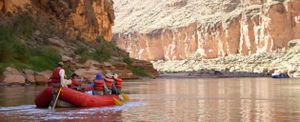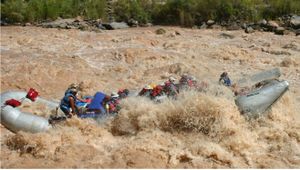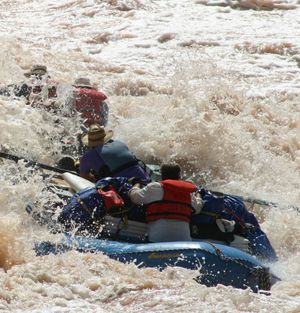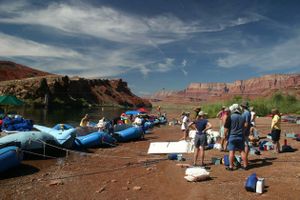Difference between revisions of "Rafting Folder"
(fix) |
(add PIC- Launch Day- LF NPS) |
||
| (One intermediate revision by the same user not shown) | |||
| Line 75: | Line 75: | ||
---- | ---- | ||
| − | [[File:PIC- Rafting CR NPS-IV.jpg|thumb]][[File:PIC- Rafting CR NPS-III.jpg|thumb]][[File:PIC- Rafting CR NPS-II.jpg|thumb]] | + | [[File:PIC- Rafting CR NPS-IV.jpg|thumb]][[File:PIC- Rafting CR NPS-III.jpg|thumb]][[File:PIC- Rafting CR NPS-II.jpg|thumb]][[File:PIC- Rafting CR NPS.jpg|thumb]] |
| + | [[File:PIC- Launch Day- LF NPS.jpg|thumb]] | ||
Latest revision as of 20:42, 16 July 2014
| Granite Gorge- Sam Jansen | |
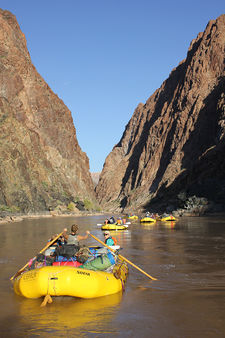 |
Data Source: Sam Jansen_April 25, 2013 Also refer to Links on NPS information on whitewater-rafting NPS Information on Whitewater-rafting
Recreation and the AMP: Grand Canyon River Running
- OVERVIEW A river trip through the Grand Canyon is a unique and special experience. It can be a life-changing event, full of grandeur, wonder, new challengers, profound encounters and tiny moments of joy. It's a time of self exploration and bonding with family and friends.
Those who haven't yet had the chance to flowat the river first hand often have a number of questions about what it's like, and why we should care so much about taking care of the place. I've tried to answer a few of those questions here.
- QUESTION: How many people raft down the river per year?
About 22,000 people travel the Colorado River through the Grand Canyon each year. About half of these travelers go on commercial trips, and about half on private trips. A commercial trip is one where an outfitter is hired, and the outfitter provides professional guides, food, boats, and all the other necessities. A private trip is a shared expense, do-it-yourself expedition. River access is controlled by the National Park Service. Private trip permits are given out through a weighted lottery. The park service used to use a straighforward, first come first serve waiting list, but that list grew to be more than 12 years long. There are sixteen commercial river outfitters listed on the Grand Canyon River Outfitters Association web page. They offer trip lengths from 2 to 18 days, with a variety of motor, oar, and paddle powered craft to choose from.
- QUESTION: What's the history of river running in the Grand Canyon?
River runners in the canyon tend to think of John Wesley Powell as the man who started it all. He and his crew of nine ran the first (known) river trip through the canyon in 1869. This was a government sponsored trip of science and exploration. The Grand Canyon was the last big patch of unknown, unmapped land in the lower 48 states. Powell and his men actually ran from the headwaters of the Colorado River in Wyoming all the way through the Grand Canyon. For the most part, after an early disaster, they ran very few rapids—instead, they lined or portaged them. The slow pace and strenuous labor were hard on both morale and supplies. By the end of their trip the men were living on bacon, dried apples, and moldy flour, washed down with copious amounts of strong coffee. Norm Nevills pioneered commercial boating in the canyon in the 1930s. He used cataract boats, small wooden craft designed for rowing through whitewater. In the 1950s, Georgie White built the first G-rig, a 33 foot long motor boat built from surplus military pontoons, and changed the face of Grand Canyon rafting. The boats were very stable, and could carry a large number of people through the canyon more quickly than oar boats. The book River Runners of the Grand Canyon, by David Lavender, is a classic, full of tales of adventure, exploration, danger and fun, and the colorful (and sometimes just plain crazy) characters who made it all happen. Highly recommended.
- QUESTION: When did rafting start to take off?
Up until 1949, only 110 people had run the river through the Grand Canyon. Starting in 1959 the number of river travelers increased by an average of 59% per year. By 1970 the river saw more than 10,000 travelers per year, and the Park Service put a cap on the number of permits it would allow each year. (Info taken from River Runners of the Grand Canyon.) What was the rafting world like before the dam was put in? Boating has changed since the 1950s. Today we have better boats, better food (and food preservation), and a whole lot more experience and knowledge. The river itself has changed, too, with the construction of Glen Canyon Dam. In pre-dam days, flows varied according to natural cycles, with lows around 3000 cfs and average Spring highs around 90,000 cfs. Water temperatures ranged from midsummer 80s to near freezing in the winter. The river ran thick with sediment—it was said to be “too thick to drink and too thin to plow”--and floods tore out vegetation and built giant sand bars. Today the dam tends to maintain flows between 8,000 and 24,000 cfs, keep the water temperature to a steady 47 degrees or so, and create a clear running river. More than ninety percent of the sediment that would once have flowed into the Grand Canyon now settles out in Lake Powell.
- QUESTION: What are the concerns of the river runners?
Boaters tend to care a great deal about the Grand Canyon, whether they have spent a few days there as commercial passengers or a few decades as river guides. Here are a few key concerns (there are certainly others):
- Stewardship of the Grand Canyon. The canyon is an important, beautiful place, unique in the world. It should be well taken care of so future generations can enjoy the same kinds of experiences there that are available to us today.
- The canyon experience. There are not many places left in the world that allow for a multi-day wilderness trips. Great whitewater, amazing side hikes, beautiful campsites, wildlife, few people, and time away from cell phones and the bustling world all add up to a special experience.
- Camping beaches. You have to sleep somewhere, and Grand Canyon beaches can be beautiful places for it. Glen Canyon Dam now retains most of the sediment that once built these beaches, and it creates steadier flow patterns that allow vegetation to encroach on the beaches that still remain.
- Natural History. An important part of the Grand Canyon experience for many people is exploring the biology of the place. Plants range from the succulents of the Sonoran and Mohave Deserts to the cottonwoods and monkeyflower along streams and springs. In some places you'll find thick wet moss just a few feet from prickly pear cactus. The animal life we encounter includes big horn sheep, lizards, birds, and snakes, and sometimes we'll get a glimpse of humpback chub or other fish. It's a richness people don't often encounter in their lives.
- Cultural History. People have inhabited and traveled through the canyon for thousands of years. Their stories put a river trip in context, and help us understand our place in the history of the world. Cultural and historic sites in the canyon bring these stories to life.
- Navigable and safe flows.
- QUESTION: Can I tube down the river?
Well...not really. The Colorado is a pool and drop river through the Grand Canyon. This means there are long stretches—often a mile or two long—of flat, slow, eddy-ridden water between rapids. Add the winds that are common throughout the canyon (nearly always blowing in the wrong direction) and a number of rapids that would be dangerous with such an uncontrollable craft, and you don't have a recipe for a fun time. Also, you'd need to be able to carry your gear. The park service has strict requirements on camping equipment for canyon trips, including a portable toilet and a sizeable firepan. It would be quite a trick to pack everything you needed on an inner tube.
- Fun fact: In 1955, two adventure-seeking lifeguards from California, Bill Beer and John Daggett, swam the length of the canyon unsupported. They wore Mae West lifejackets, and each towed two waterproof rubber boxes of supplies. They completed their trip in 25 days and had a good time, but no self-supported swimming trip has been allowed since. (Look for the book We Swam the Grand Canyon—it's worth a read.)
- QUESTION: What are the Lowest/Highest flow releases that don't become a safety issue for boaters?
This question is more complex than it might at first seem. In general, running the Colorado River through the Grand Canyon is a fairly safe experience, when it's treated with the proper respect. There are a few tricky places, but for the most part the rapids are straightforward, and because it is a pool and drop river there tend to be good zones below rapids for recovering from mishaps. However, some flow levels are more difficult than others. At flows below 8,000 cfs or so, some of the rockier rapids (such as Hance and Deubendorf) become very challenging, especially for motor rigs and dories. Below 5,000 cfs, smashed boats, destroyed motors, and rafts wrapped on rocks become real problems, and the river becomes more or less impassable for some craft. The risks at high flows are of a different kind. The river moves faster and hydraulics become more powerful. Some rapids become smaller or disappear altogether, but some become very large. But the river is runnable at any high flow the dam will allow. Truth be told, risks are inherent to boating through the Grand Canyon at any water level. Usually it all goes well, but there are plenty of opportunities for things to get interesting. (If you're in the mood to watch things go very wrong, search for the keywords “Lava Falls Carnage” on YouTube. For videos with a higher ratio of fun to carnage, have a look at www.youtube.com/user/smdjansen.)
- QUESTION: What flows do river runners prefer?
An “ideal” river flow would be hard to come by, even if you only consider it's effects on boating. Different people have different thoughts depending on their whitewater skills, their craft, and the kind of experience they're after. And different rapids have different “ideal” flows. For example, the Roaring Twenties (the series of rapids from mile 20 to mile 26 or so) tend to be very fun at flows around 10,000 cfs, but then wash out a bit in the high teens. Some people think Hermit Rapid reaches it's biggest friendly level at about 18,000 cfs, but some are just as happy to row it at a tamer 12,000. A kind of ideal might be found in something resembling natural variation. An important part of Grand Canyon rafting is the wilderness feel and unpredictability of the experience. It's about accepting the challenges of the water level you happen to get and doing your best to get through it. Adventurous boaters don't want a uniformly-managed river they can memorize and run by rote. They want the challenge of meeting the river on its own terms. Also, flows affect more than just the whitewater. At higher flows the river moves faster, and that means quicker travel times for boats. This is especially noticeable on rowing trips, where higher flows can drop travel time by an hour or two a day, which leaves more daylight for hiking or quality time in camp.
- QUESTION: What do trips cost?
- QUESTION: What economic benefit does rafting add to the surrounding community?
The cost of a commercial trip varies by company, trip length, craft, and other aspects. A quick web search shows a range from about $1200 for a three day motor trip to $5000 for a fifteen day dory trip. Private trips are shared-costs, low overhead events, and can vary widely in cost. If you own a boat and the proper gear, food will be your main expense, and an eighteen day trip could cost $1000 or so. In total, Grand Canyon river running resulted in an estimated $21,100,000 of regional expenditures to the greater Grand Canyon economy in 2001. It's an important part of the local economy. (Regional Economic Impacts of Grand Canyon River Runners, 2001, by Evan Hjerpe and Dr. Yeon-Su Kim)
- There's a lot more to be said about river running in the Grand Canyon. Search the internet and you'll find many trip logs and hundreds of photos. Search the library and you'll find many books worth perusing. A Grand Canyon river trip is a unique, life-changing experience, and we should be sure to take care of the place so that experience is available for generations to come.
- DID YOU KNOW--Not all National Parks allow river recreation: It is a federal offense to kayak, raft or otherwise float any river in Yellowstone National Park.
- Useful links:
- Grand Canyon River Guides: http://www.gcrg.org
- Grand Canyon Private Boaters Association: http://gcrpba.org
- Grand Canyon River Outfitters Association: http://www.gcroa.org
- Grand Canyon River Runners Association: http://www.gcriverrunners.org
- NPS Information on Whitewater-rafting
